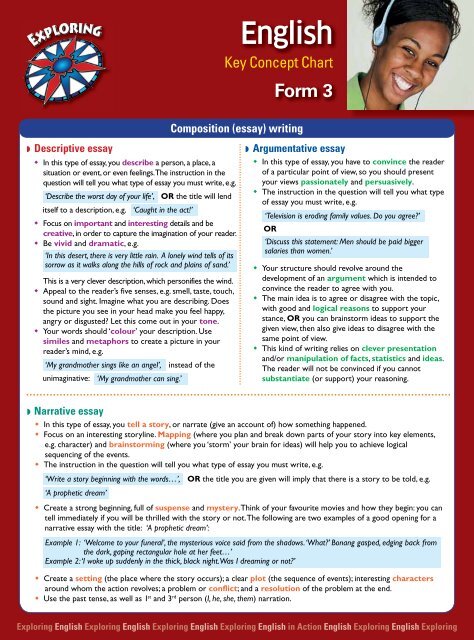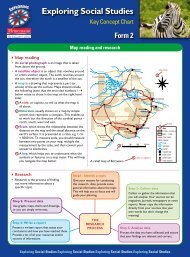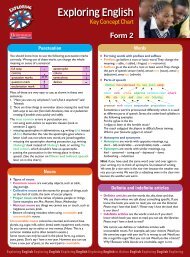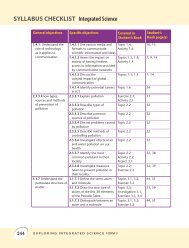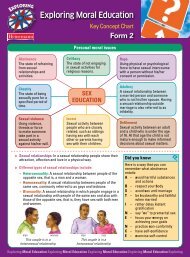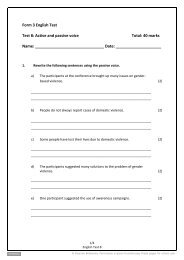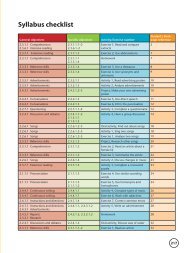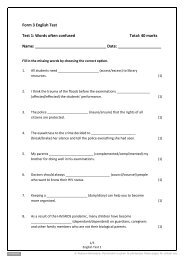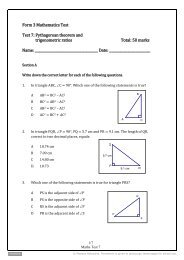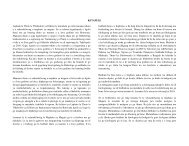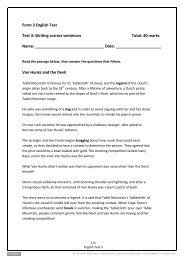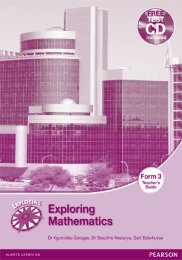Key Concept Chart - Pearson
Key Concept Chart - Pearson
Key Concept Chart - Pearson
Create successful ePaper yourself
Turn your PDF publications into a flip-book with our unique Google optimized e-Paper software.
English<strong>Key</strong> <strong>Concept</strong> <strong>Chart</strong>Form 3Composition (essay) writing◗ Descriptive essay• In this type of essay, you describe a person, a place, asituation or event, or even feelings. The instruction in thequestion will tell you what type of essay you must write, e.g.‘Describe the worst day of your life’, OR the title will lenditself to a description, e.g. ‘Caught in the act!’• Focus on important and interesting details and becreative, in order to capture the imagination of your reader.• Be vivid and dramatic, e.g.‘In this desert, there is very little rain. A lonely wind tells of itssorrow as it walks along the hills of rock and plains of sand.’This is a very clever description, which personifies the wind.• Appeal to the reader’s five senses, e.g. smell, taste, touch,sound and sight. Imagine what you are describing. Doesthe picture you see in your head make you feel happy,angry or disgusted? Let this come out in your tone.• Your words should ‘colour’ your description. Usesimiles and metaphors to create a picture in yourreader’s mind, e.g.‘My grandmother sings like an angel’, instead of theunimaginative: ‘My grandmother can sing.’◗ Argumentative essay• In this type of essay, you have to convince the readerof a particular point of view, so you should presentyour views passionately and persuasively.• The instruction in the question will tell you what typeof essay you must write, e.g.‘Television is eroding family values. Do you agree?’OR‘Discuss this statement: Men should be paid biggersalaries than women.’• Your structure should revolve around thedevelopment of an argument which is intended toconvince the reader to agree with you.• The main idea is to agree or disagree with the topic,with good and logical reasons to support yourstance, OR you can brainstorm ideas to support thegiven view, then also give ideas to disagree with thesame point of view.• This kind of writing relies on clever presentationand/or manipulation of facts, statistics and ideas.The reader will not be convinced if you cannotsubstantiate (or support) your reasoning.◗ Narrative essay• In this type of essay, you tell a story, or narrate (give an account of) how something happened.• Focus on an interesting storyline. Mapping (where you plan and break down parts of your story into key elements,e.g. character) and brainstorming (where you ‘storm’ your brain for ideas) will help you to achieve logicalsequencing of the events.• The instruction in the question will tell you what type of essay you must write, e.g.‘Write a story beginning with the words…’,‘A prophetic dream’OR the title you are given will imply that there is a story to be told, e.g.• Create a strong beginning, full of suspense and mystery. Think of your favourite movies and how they begin: you cantell immediately if you will be thrilled with the story or not. The following are two examples of a good opening for anarrative essay with the title: ‘A prophetic dream’:Example 1: ‘Welcome to your funeral’, the mysterious voice said from the shadows. ‘What?’ Bonang gasped, edging back fromthe dark, gaping rectangular hole at her feet…’Example 2: ‘I woke up suddenly in the thick, black night. Was I dreaming or not?’• Create a setting (the place where the story occurs); a clear plot (the sequence of events); interesting charactersaround whom the action revolves; a problem or conflict; and a resolution of the problem at the end.• Use the past tense, as well as 1 st and 3 rd person (I, he, she, them) narration.Exploring English Exploring English Exploring English Exploring English in Action English Exploring English Exploring
Letter writingThere are two main types of letter:• The informal or friendly letter which you write to friends, relatives and acquaintances. The language and tone of thisletter are therefore friendly, playful or conversational.• The formal or business letter which you write to the Editor of a newspaper, manager of a store, a politician, or themanager of a company, for business reasons. The language and tone of this letter are polite and businesslike.• Both types of letters should follow a set format.◗ The informal (or friendly) letterThis letter should be set out as follows:Get straight into the subject ofyour letter. Do not waste timeasking ‘How are you these days?’At the end of an informalletter you can say…Salutation or greeting(which can be informal)Hi Reofilwe or Dear ReofilweI was very sorry to hear about your accident…Body of letter …Conclude your letter (very briefly)Begin with your full address onthe right-hand side, followedby the dateWarm regards / Your loving friend / Lots of lovePlot 50441Phakalane EstateGaboroneBotswana30 June 2011Next, in the body of yourletter (which may be two ormore paragraphs), expandon your reasons for writing◗ The formal (or business) letter• In this letter, you are writing to someone who requires a formal letter in order to do something for you.Therefore, you have to write in such a way that your tone and presentation (the overall impression that you will give)will put the recipient in the right frame of mind to grant your request.• Use polite language and communicate your needs clearly.• This letter should be set out as follows:The title, nameand address ofthe recipientshould be setagainst the lefthandmarginYourintroductionshould explainfurther whyyou are writingthis letterThe Managing DirectorTJ WholesalersFairgrounds Office ParkP O Box 0047GaboroneDear Sir / MadamComplaint about stale produce on your countersIntroductionThere should beno punctuation onthe two addressesThe formal salutation or greetingBegin with your full address and thedate on the right-hand sidePlot 49800Block 5Gaborone30 June 2011The subject heading(highlighted andunderlined), shouldfollow immediatelyafter the salutation,to summarise thepurpose of your letterNotes whichexpand onthe matterEnd with…BodyConclusionYours faithfully / Yours truly / Yours sincerelySay what you expectfrom the recipient, andthank them in advancefor their helpJoe Kgathi (Mr)Sign your name, and then print it(also add your title Mr/Mrs/Miss/Ms)NOTE: Aside from the sender’s address, you should write everything else flush against the left hand margin.Remember to use the block paragraph method, where you leave a line between each paragraph. Do not mix paragraphingmethods, i.e. indent first, then block paragraph next.Exploring English Exploring English Exploring English Exploring English Exploring English Exploring English Exploring
Literature (essay) writing◗ Your Junior Secondary syllabus focuses on the study of these genres: short story, drama, novel and poetry. Themind map below summarises what aspects you need to know well in order to get good marks in an essay based on aparticular genre.NovelUnderstanding that anovel includes the followingfeatures: narrative (or story),point of view, theme, conflict,setting, structure, etcWhat a goodliterature essayshowsShort storyUnderstanding of the plot,setting, theme and message.Also show understanding of howlanguage is used to create moodand to paint pictures (throughthe use of similes, metaphors,personification, etc)PoetryUnderstanding of poetryconcepts such as structure ofpoems, rhyme, rhythm, stanza, imagery,personification, theme, alliteration (e.g. ‘big, black,bald bully’), assonance, onomatopoeia (e.g. ‘theleaves rustle’) and the effect of poetic deviceson the overall message (and impact) ofa given poemDramaUnderstanding of theplot, characters, context(and how it influences the storyand characters), conflict,climax, etcHere are five steps that will help you to tackle literatureessays more effectively.Step 1: Be clear what your task is• Understand the topic before you begin to work on it,i.e. break the topic up into its important parts.• Identify task words, e.g. explain (why?); describe(how?); discuss (talk about); or evaluate (give yourown reasons for).• Identify content words, i.e. the words that tell youwhat the topic is all about, e.g.‘Discuss (task word) the incident in Things FallApart where Okonkwo cuts off the head of the headmessenger with a machete (content words) andexplain (task word) how this incident completelychanges Okonkwo’s character (content words).’Step 2: Choose the relevant facts from aset book• Which details address your topic? Make notes as ideas popinto your head, and make sure the ideas are connected.• Make sure all your ideas are relevant to the topic orquestion.Step 3: Arrange your ideas in a logicalsequence• Make notes on which idea you will begin with. How willyou link your ideas?• Jot down the main ideas and arrange them in the orderin which you will present them.Step 4: Write your first draft• Arrange your ideas into a first draft, and once againcheck that what you are writing is relevant to the topic.• Make sure you are presenting your ideas in a logicalsequence.Step 5: Write your essay, and check your workbefore you hand it in• Check spelling and grammar.• Make sure each paragraph focuses on one main idea, andthat paragraphs flow well from one to the next.• Check that you are addressing the topic throughout,i.e. that your text is always relevant.Lastly, if you want to quote what a character says in a setbook (word for word), use inverted commas as you havebeen taught.Exploring English Exploring English Exploring English Exploring English in Action English Exploring English Exploring
EXPL ENGLISH 3SB CV.indd 1This course is supported by the onlineA NEW teaching experience!www.longmanafrica.co.zaFor new curriculum implementation in BotswanaHeinemann Exploring Form 3 covers all the requirements of theRevised Junior Secondary School syllabus.Heinemann Exploring helps students to understand the subject:• Learning objectives explain what students need to be able to do• Clear and concise language makes content accessible• Varied activities provide unique learning opportunities• Additional information encourages students to explore further.Heinemann Exploring helps students to pass the subject:• Chapter summaries reinforce learning• Revision opportunities provide valuable exam practice• <strong>Key</strong> <strong>Concept</strong> <strong>Chart</strong>s summarise important concepts for quick revision• Test CDs so teachers can evaluate students’ progress.Heinemann Exploring - a new teaching and learning experience!Heinemann books are printed on qualitypaper, and have sturdy, long-lasting covers.I SBN 978-99912-416-4-79 789991 241647Jane Chanda , Shimmer Chinodya, Florence Kgomanyane2011/07/19 4:31 PMTips for effective essay writingSix steps to writing a good essay in an examinationStarthereChoose your topic• Choose a topic thatinterests you the mostout of all the topics youhave been given.• Choose the topic on which youhave lots of interesting things towrite on, otherwise you will runout of ideas and begin to waffle.• If you have been given guidelineson what to cover in the essay,follow the instructions,adding more details asnecessary.Brainstorm ideasAdd the finishing touches• Check your spelling.• Read through your essay again.• Check that you have followed the instructions.• Check the order of your paragraphs – does it make sense?• Check your grammar and punctuation.Writing agood essayWrite the conclusion• Sum up the main points.• Explain your feelings aboutthe topic.Write the introduction• Right away, give an idea of whatthe essay is all about.• Grab the reader’s attention!• Write down all the ideas that comeinto your head.• Arrange your ideas using mindmaps – these are very helpful asthey help you to focus your thinking,as well as to select, sequence and/orlink ideas logically.Write the body• Write down all the main points.• Write down the sub-points, i.e. those thatsupport or develop the main points.• Arrange all your points in logical order.A good essay• is well structured andfocused• is arranged logically• grabs the reader’s attention• uses colourful languagewhich will appeal to thereader’s imagination andsenses• lists references used asnecessaryParagraphs: the secret to easy reading!• Do not forget to paragraph your work. Paragraphs will make your essay easy to read.• Each paragraph should have a topic sentence (which introduces or sums up theinformation in the paragraph) and developers (which provide further details in theparagraph), e.g.Thabang and Tlotlego were very busy the week before Christmas.They watered the garden and cleaned the house. developerThey washed and ironed their clothes. Then we all went shopping for presents.developerdevelopertopic sentenceExploringEnglishFREEKEY CONCEPT CHARTWITH STUDENT’S BOOKLISTENING AND TEST CDWITH TEACHER’S GUIDEForm 3Student’sBookContact details<strong>Pearson</strong> Botswana: Tel: +267 3922969 Fax: +267 3922682Plot 14386, New Lobatse Road, G-West Industrial Site,HEINEMANNGaborone, Botswana. Website: www.longmanafrica.co.zaExploring English Form 3 Student’s BookExploringEnglishForm 3Student’sBookI SBN 978-99912-594-7-59 789991 259475


